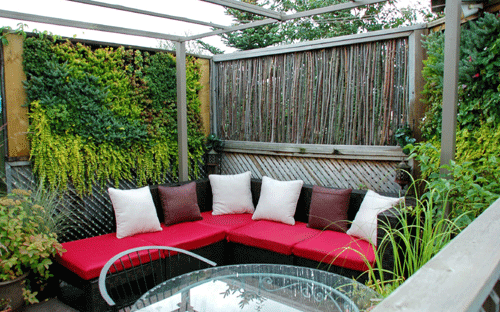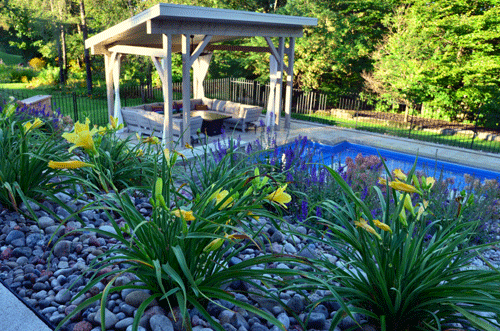Story and Photos by Melanie Rekola for Our Home Magazine
Considering groundcovers are often in the forefront of garden beds everywhere, it seems little praise is given to these tough, tiny plants.
Groundcovers can add a whole new dimension of colour to your garden through their foliage, texture and abundant bloom. Many, with their trailing nature can soften hard stonework when tucked in crevices, or be encouraged to spill down the front of retained beds giving an “aged” feel. Groundcovers can also help retain slopes and discourage weed growth. Some are so strong that they can act as a lawn or path substitution. Read on to discover more.
MELANIE’S PLANT PICKS:
Stonecrop (sedum) – There are so many lovely trailing varieties of the sedum family that I cannot pick just one! The fleshy, succulent leaves of this little plant often look like a flower. It comes in a variety of foliage and blooms colours, plus it’s drought tolerant and happy in lean soil. Bees and hummingbirds love them and the presence of pollinators is an important indicator of a healthy garden. Stonecrop favours sun but will tolerate partial shade. My favourites are:
Angelina (Sedum rupestre) – This spiky evergreen variety offers bright golden foliage and turns orange in fall, with yellow flowers in early summer.
Dragon’s Blood (Sedum spurium) – The well-loved stonecrop is a semi-evergreen specimen with rich reddish foliage and bright pink blooms in late summer.
Bronze Carpet (Sedum spurium) – This showy stonecrop sports brilliant bronze red semi-evergreen foliage with flattering pink flowers.
Miniature Stonecrop (Sedum requieni) – This miniature stonecrop is a tiny leafed evergreen sedum and is the only one that tolerates foot traffic. It forms a dense mat with tiny white flowers and is extremely hardy.
Creeping Phlox (Plox subulata) – Dense and low growing, this soft-looking plant is a prolific bloomer! It’s covered in small purple, pink, white or variegated flowers in spring, with short, stiff evergreen foliage. This low-maintenance perennial prefers sun/part sun and is accepting of lean soils.
Golden Scotch Moss (Sagina subulata) – Very dense and low growing, this mounding evergreen perennial, with tiny star-like white flowers in spring, boasts attractive chartreuse foliage. It tolerates foot traffic easily but its shallow root system requires steady watering to thrive. It prefers part shade.
Hens and Chicks (Sempervivum) – I like all varieties of this drought tolerant succulent. Their rosettes display dazzling progressive colour changes throughout the season. They favour full sun to bring out their rich colour. Sempervivums will bloom after the second or third year. An odd looking flower stalk will shoot up from the centre of the main rosette with a cluster of flowers. After the flower dies, gently twist off the stalk. The main rosette has put on new offsets that will fill in.
Cranesbill (Geranium Bloody) – Of the many variations of the Cranesbill family, my absolute favourite variety is Bloody, which, to me, is one of the best Cranesbill introductions ever. It bears handsome dark green foliage with happy, upright clusters of bright violet-purple, cup-shaped flowers. Bloom period begins in early summer and continues on throughout the garden season. It likes sun to part shade.
Creeping Jenny/Moneywort (Lysimachia nummularia or Golden Creeping Jenny) – Creeping Jenny is accused of being an aggressive perennial, however the Goldilocks variety is restrained in habit. It is ideal to combat soil erosion or on rock walls and tolerates lean soil. Preferring full sun to part shade, its yellow-green foliage makes a bright statement when paired with common greens typically found in the garden. The name “wort” suggests medicinal use; it was used by early English herbalists to heal superficial wounds of both man and serpents. It was also used for ulcers, scurvy, hemorrhages and ailments of the lungs.
Dianthus (Dianthus) – Dianthus range in colour from pink, to red, to white flowers with notched petals and finely textured leaves. Sweet Williams (Dianthus barbatus) are large and are biennial or short-lived perennials covered with bicolour flowe4rs in late spring. Pinks are low-growing, low-care dianthus suitable for rock gardens with happy open-faced flowers and attractive grey-green foliage. Dianthus prefers full sun and won’t stand wet soils.
Creeping Thyme Elfin or Minus (Thymus praecox Elfin or Minus) – This tiny gem has gorgeous miniature flowers and compact leaves. This is another “walk upon” plant and when trod on will let go its thymey scent – plus it’s edible! It favours full sun and tolerates lean soil.
A host of mature, entangled groundcovers an rival the beauty of a tapestry. But be careful to consider the aggressive habit of many and choose the right plant for the right environment. Groundcovers are not only at home n the applications mentioned – consider planting a “mini” garden in a planter or two. Children love this pint-sized forest idea, or dare I say living wall. Perhaps it’s just the thing to take a ho-hum exterior wall to a front-and-centre showpiece!
View original story and pictures at: http://canadablooms.com/wp-content/uploads/2017/04/MinitureMarvels1.pdf


